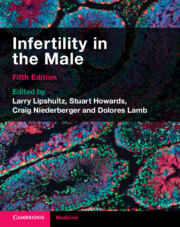Book contents
- Infertility in the Male
- Infertility in the Male
- Copyright page
- Contents
- Contributors
- Foreword
- Abbreviations
- Introduction
- Section 1 Scientific Foundations of Male Infertility
- Chapter 1 Anatomy and Embryology of the Male Reproductive Tract and Gonadal Development, the Epididymis, and Accessory Sex Organs
- Chapter 2 Cellular Architecture and Function of the Testis
- Chapter 3 Maturation and Function of Sperm
- Chapter 4 The Male Reproductive Endocrine System
- Chapter 5 Erection, Emission, and Ejaculation
- Chapter 6 Genomics, Epigenetics, and Male Reproduction
- Section 2 Clinical Evaluation of the Infertile Male
- Section 3 Laboratory Diagnosis of Male Infertility
- Section 4 Treatment of Male Infertility
- Section 5 Health Care Systems and Culture
- Index
- References
Chapter 3 - Maturation and Function of Sperm
from Section 1 - Scientific Foundations of Male Infertility
Published online by Cambridge University Press: 08 July 2023
- Infertility in the Male
- Infertility in the Male
- Copyright page
- Contents
- Contributors
- Foreword
- Abbreviations
- Introduction
- Section 1 Scientific Foundations of Male Infertility
- Chapter 1 Anatomy and Embryology of the Male Reproductive Tract and Gonadal Development, the Epididymis, and Accessory Sex Organs
- Chapter 2 Cellular Architecture and Function of the Testis
- Chapter 3 Maturation and Function of Sperm
- Chapter 4 The Male Reproductive Endocrine System
- Chapter 5 Erection, Emission, and Ejaculation
- Chapter 6 Genomics, Epigenetics, and Male Reproduction
- Section 2 Clinical Evaluation of the Infertile Male
- Section 3 Laboratory Diagnosis of Male Infertility
- Section 4 Treatment of Male Infertility
- Section 5 Health Care Systems and Culture
- Index
- References
Summary
Human sperm are created in the testis via a highly regulated and complex hormonal pathway arising from the hypothalamic–pituitary–testicular (HPT) axis under complex paracrine control by growth factors and cytokines. Following their creation, sperm must travel through the seminiferous tubules, epididymis, vas deferens, ejaculatory ducts, and urethra until they are expelled through ejaculation into the female genital tract. Fertilization capabilities of the sperm require morphologic and molecular changes that are acquired during transit of sperm through the male and female reproductive tracts.
- Type
- Chapter
- Information
- Infertility in the Male , pp. 39 - 61Publisher: Cambridge University PressPrint publication year: 2023

